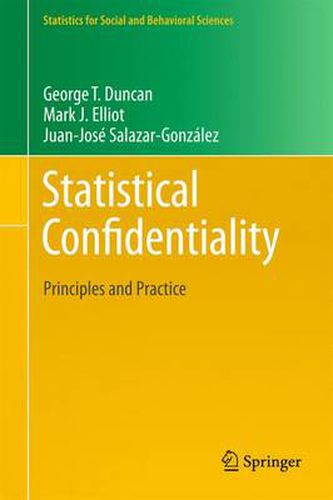Readings Newsletter
Become a Readings Member to make your shopping experience even easier.
Sign in or sign up for free!
You’re not far away from qualifying for FREE standard shipping within Australia
You’ve qualified for FREE standard shipping within Australia
The cart is loading…






This title is printed to order. This book may have been self-published. If so, we cannot guarantee the quality of the content. In the main most books will have gone through the editing process however some may not. We therefore suggest that you be aware of this before ordering this book. If in doubt check either the author or publisher’s details as we are unable to accept any returns unless they are faulty. Please contact us if you have any questions.
Because statistical confidentiality embraces the responsibility for both protecting data and ensuring its beneficial use for statistical purposes, those working with personal and proprietary data can benefit from the principles and practices this book presents. Researchers can understand why an agency holding statistical data does not respond well to the demand, Just give me the data; I’m only going to do good things with it. Statisticians can incorporate the requirements of statistical confidentiality into their methodologies for data collection and analysis. Data stewards, caught between those eager for data and those who worry about confidentiality, can use the tools of statistical confidentiality toward satisfying both groups.
The eight chapters lay out the dilemma of data stewardship organizations (such as statistical agencies) in resolving the tension between protecting data from snoopers while providing data to legitimate users, explain disclosure risk and explore the types of attack that a data snooper might mount, present the methods of disclosure risk assessment, give techniques for statistical disclosure limitation of both tabular data and microdata, identify measures of the impact of disclosure limitation on data utility, provide restricted access methods as administrative procedures for disclosure control, and finally explore the future of statistical confidentiality.
$9.00 standard shipping within Australia
FREE standard shipping within Australia for orders over $100.00
Express & International shipping calculated at checkout
This title is printed to order. This book may have been self-published. If so, we cannot guarantee the quality of the content. In the main most books will have gone through the editing process however some may not. We therefore suggest that you be aware of this before ordering this book. If in doubt check either the author or publisher’s details as we are unable to accept any returns unless they are faulty. Please contact us if you have any questions.
Because statistical confidentiality embraces the responsibility for both protecting data and ensuring its beneficial use for statistical purposes, those working with personal and proprietary data can benefit from the principles and practices this book presents. Researchers can understand why an agency holding statistical data does not respond well to the demand, Just give me the data; I’m only going to do good things with it. Statisticians can incorporate the requirements of statistical confidentiality into their methodologies for data collection and analysis. Data stewards, caught between those eager for data and those who worry about confidentiality, can use the tools of statistical confidentiality toward satisfying both groups.
The eight chapters lay out the dilemma of data stewardship organizations (such as statistical agencies) in resolving the tension between protecting data from snoopers while providing data to legitimate users, explain disclosure risk and explore the types of attack that a data snooper might mount, present the methods of disclosure risk assessment, give techniques for statistical disclosure limitation of both tabular data and microdata, identify measures of the impact of disclosure limitation on data utility, provide restricted access methods as administrative procedures for disclosure control, and finally explore the future of statistical confidentiality.